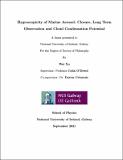Hygroscopicity of marine aerosol: Closure, long term observation and cloud condensation potential

View/
Date
2021-09-18Embargo Date
2025-09-18
Author
Xu, Wei
Metadata
Show full item recordUsage
This item's downloads: 0 (view details)
Abstract
Marine aerosols have a profound impact on the global climate system by scattering solar radiation and serving
as seeds for cloud formation. However, the marine aerosols in current models are still poorly represented
and lack constraints. In this work, the physico-chemical properties of marine aerosol were obtained in Mace
Head Atmospheric Research Station on the west coast of Galway, Ireland. The worked is centred by the
data obtained by humidity tandem differential mobility analyzer (HTDMA) and combined with other aerosol
measurements, e.g. aerosol mass spectrometer, scanning mobility particle sizer (SMPS). This work aims to
characterise marine aerosols in terms of hygroscopicity and their relevant climate impacts and consists of the
following sections:
• We demonstrate that the hygroscopicity of marine aerosols can be predicted in high temporal resolution
by using bulk PM1 chemical composition. This is the first time that the hygroscopicity of marine aerosol
has been predicted by the chemical composition that contains sea salt.
• We present a statistical analysis of a five-year dataset of hygroscopicity measurement, which is the
longest dataset of its kind to date. From this, a contrasting seasonal difference between marine and
continental aerosols has been found.
• The number concentrations of cloud condensation nuclei (CCN) are predicted by using hygroscopicity
and chemical composition. The impact of common assumptions, including size-dependent hygroscopicity and mixing state are quantified.
• The sea spray aerosol is one of the most important species of marine aerosol, and the sea spray number
is crucial in determining the CCN numbers. However, the sea spray number cannot be measured by
conventional methods. As such, we have developed a method to use size-resolved hygroscopicity data to
distinguish the sea spray and other species, and we found that the conventional method underestimated
the sea spray number by up to tenfold, thus greatly overlooking their climate effects.

